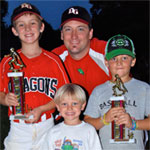Advanced Outdoor Practices
Once your team has gotten used to being outdoors, it’s now time to focus on getting them game ready, that means going over game situations and scenarios. Depending on the age of your team will determine the different types of scenarios that you will want to practice. The older the team, the more intricate you can get.
Different types of game situations are:
Outdoor Practice Basics
If your team has been practicing indoors for the past few months, chances are you have done a ton of drill work to get your team in shape: Ground balls, throwing drills, pitching drills, hitting drills. Your space was limited, so you made the best of it, in perfect conditions. Outdoor practices now need to prepare your team for game situations and imperfect conditions.
Indoor Throwing and Arm Strengthening
For teams that are practicing indoors, it is important to continue to strengthen the players’ arms. If there is not enough room to throw long or you are faced with a poorly lit facility, you may have to be inventive. You can still utilize this indoor time to gain arm strength. You want to have your players’ arms game ready by your first game.
How To Plan A Baseball Practice
Practice design is not as intimidating as one would think. However, for the novice coach, it may be a daunting task. Baseball Zone’s Practice Planner makes it quick and easy. We have a bunch of great drills and formats already in there for you to choose from. Just point, click and print.
Here is a quick template that touches on the most important aspects of a practice for the younger kids:
Drills, Drills and More Drills
Drills are a great way to get the player to feel what you are trying to get them to feel. If done properly, they can benefit the players immensely. If done improperly, they are reinforcing bad habits.
“Practice doesn’t make perfect, practice makes permanent.”
Occupy Baseball, 99% vs. 1%
This time of year, many travel baseball teams here in the Midwest have secured inside training facilities on a weekly basis. Travel baseball is big business now. Players pay a pretty penny for coaches, training, leagues and tournaments. Training sessions for teams inside can last anywhere from an 1-2 hours. If your team is lucky enough (or has spent enough money), you will rent a field and some cages.
Fielding Footwork
While it’s safe to assume that the vast majority of major leaguers possess great arm strength, a closer look may reveal something you might not expect. Players seldom during a game “air it out.” Not every pitch or play requires a player to use 100% of his arm speed/strength. But when they have to, how do they do it?
What Really Loses The Game
Time and time again throughout the course of the season, games are lost more frequently by poor fielding. Think back to last year and remember how many times you won and lost and what the cause was. A missed ground ball, fly ball or bad throw turns into a run(s). An extra out may be all a team needs to push across the winning run or build a cushion to put the game out of reach.
Coach Training for Leagues
Volunteer coaches are vital to youth baseball, but many are first-timers who can get easily overwhelmed or frustrated. Training your coaches is crucial to your players’ development and happiness, as well as the success of your league.
Provide the coaches in your league with all the tools they need to succeed. Baseball Zone’s League Packages are customized from the following available options:

